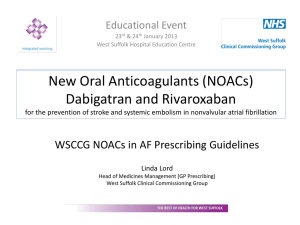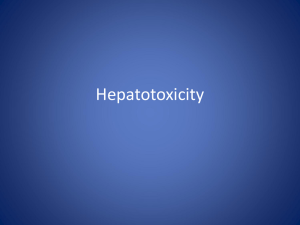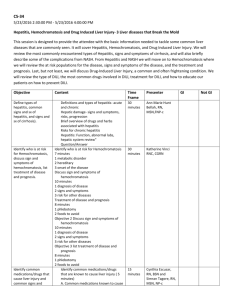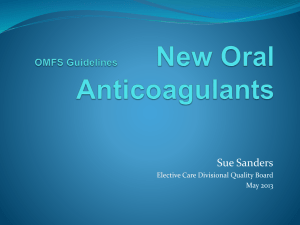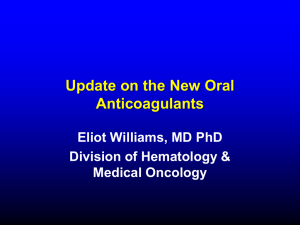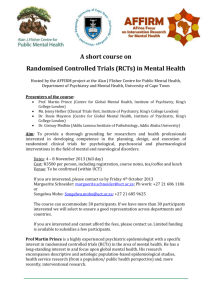Risk of Drug-induced Liver Injury With the New Oral Anticoagulants
advertisement
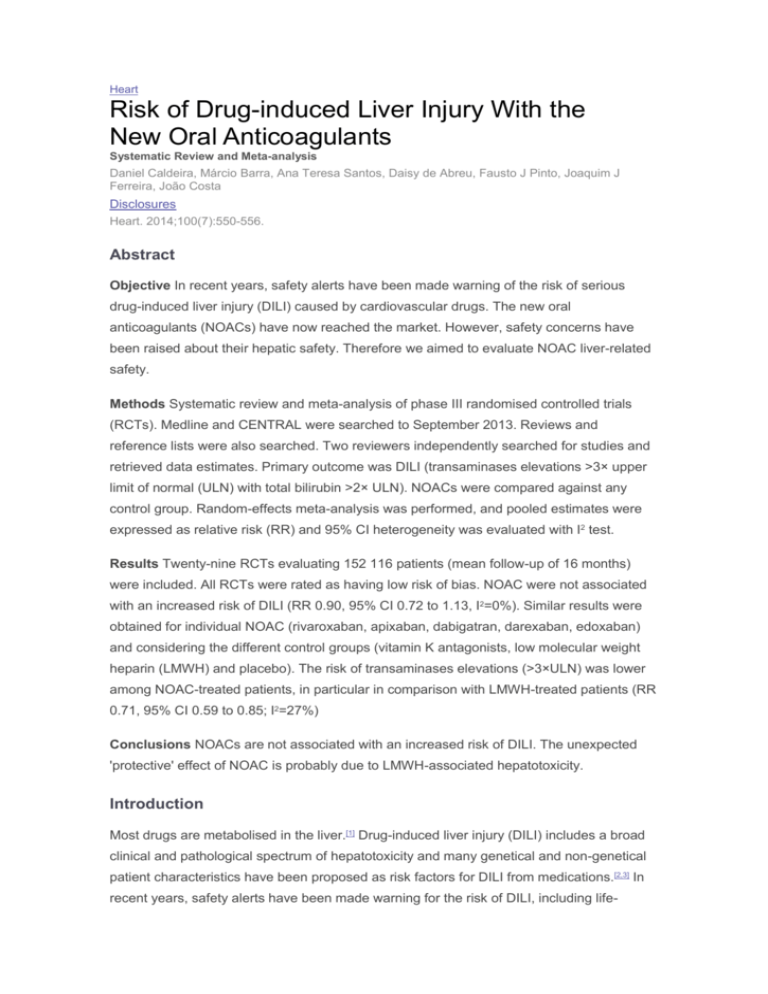
Heart Risk of Drug-induced Liver Injury With the New Oral Anticoagulants Systematic Review and Meta-analysis Daniel Caldeira, Márcio Barra, Ana Teresa Santos, Daisy de Abreu, Fausto J Pinto, Joaquim J Ferreira, João Costa Disclosures Heart. 2014;100(7):550-556. Abstract Objective In recent years, safety alerts have been made warning of the risk of serious drug-induced liver injury (DILI) caused by cardiovascular drugs. The new oral anticoagulants (NOACs) have now reached the market. However, safety concerns have been raised about their hepatic safety. Therefore we aimed to evaluate NOAC liver-related safety. Methods Systematic review and meta-analysis of phase III randomised controlled trials (RCTs). Medline and CENTRAL were searched to September 2013. Reviews and reference lists were also searched. Two reviewers independently searched for studies and retrieved data estimates. Primary outcome was DILI (transaminases elevations >3× upper limit of normal (ULN) with total bilirubin >2× ULN). NOACs were compared against any control group. Random-effects meta-analysis was performed, and pooled estimates were expressed as relative risk (RR) and 95% CI heterogeneity was evaluated with I2 test. Results Twenty-nine RCTs evaluating 152 116 patients (mean follow-up of 16 months) were included. All RCTs were rated as having low risk of bias. NOAC were not associated with an increased risk of DILI (RR 0.90, 95% CI 0.72 to 1.13, I2=0%). Similar results were obtained for individual NOAC (rivaroxaban, apixaban, dabigatran, darexaban, edoxaban) and considering the different control groups (vitamin K antagonists, low molecular weight heparin (LMWH) and placebo). The risk of transaminases elevations (>3×ULN) was lower among NOAC-treated patients, in particular in comparison with LMWH-treated patients (RR 0.71, 95% CI 0.59 to 0.85; I2=27%) Conclusions NOACs are not associated with an increased risk of DILI. The unexpected 'protective' effect of NOAC is probably due to LMWH-associated hepatotoxicity. Introduction Most drugs are metabolised in the liver.[1] Drug-induced liver injury (DILI) includes a broad clinical and pathological spectrum of hepatotoxicity and many genetical and non-genetical patient characteristics have been proposed as risk factors for DILI from medications.[2,3] In recent years, safety alerts have been made warning for the risk of DILI, including life- threatening liver failure, caused by cardiovascular drugs. For example, dronedarone, an antiarrhythmic drug, can cause serious liver injury,[4] and ximelagatran, an oral direct thrombin (IIa) inhibitor, has been withdrawn from the market in 2004 due to the risk of DILI.[5] These safety warnings only emerged with postmarketing experience because hepatic adverse drug reactions due to cardiovascular drugs are relatively uncommon, but potentially serious, and premarketing clinical trials are underpowered to detect differences between treatment arms. These recent high profile cases of serious liver adverse reactions associated with cardiovascular drugs have amplified the need for careful premarketing analysis of DILI risk associated safety. In the last 5 years, new oral anticoagulants (NOACs), with direct inhibition of factors IIa or Xa, have granted European and US marketing authorisation for the prevention of thrombotic events in high-risk adult patients. The past history of ximelagatran further contributed to a close surveillance and reporting of hepatic adverse events during NOAC clinical trials. In fact, with the exception of dabigatran, NOACs are metabolised by the liver (CYP3A4 involvement) and, according to the public assessment reports of these drugs they all are associated with increases in transaminases and abnormal liver function, with an incidence up to 1 in 100 to 1 in 1000 people.[6–8] Furthermore, the 2013 European guidance for the use of NOAC recommends yearly monitoring of liver function.[9] In this context, we aimed to better estimate the risk of hepatic adverse drug reactions associated with NOAC by performing a systematic review and meta-analysis of phase III randomised controlled trials (RCTs). Methods Guidelines This systematic review followed the Preferred Reporting Items for Systematic Reviews and Meta-analyses framework guidelines.[10] Studies' Eligibility Criteria Phase III RCTs comparing NOACs, including direct inhibitors of IIa (dabigatran) or Xa (apixaban, darexaban, edoxaban, or rivaroxaban), against any control group (placebo, no-treatment or standard care, nonpharmacological interventions or any drug). Only phase III RCTs were considered to avoid bias in risk estimation due to statistical effects of rare events and the impact of small size underpowered studies on meta-analysis results.[11–14] Furthermore, we were interested in determining the risk associated with the approved and commonly used doses of the NOAC. All RCTs were considered for inclusion irrespective of patients' disease, comorbidities, background therapy, NOAC treatment duration or follow-up. Only trials reporting hepatic data as a prespecified outcome were included to avoid selective reporting. Trials had to provide laboratory data for transaminases and bilirubin. Primary outcome was DILI, defined as increases in serum levels of transaminases above three times the upper limit of normal (ULN) and total bilirubin above two times the ULN. According to Hy's law, the outcome defined above is the most specific predictor of potential severe hepatotoxicity.[15] Secondary outcomes were incidence of transaminases elevation >3× ULN, and incidence of bilirubin elevation >2× ULN. Search Method Investigators retrieved potential eligible studies through an electronic search in Medline and Cochrane Library, run in September 2013. Search strategy for Medline (see supplementary online) included free text and Medical Subjects Headings terms without language restrictions. Additionally, we checked the references of systematic reviews and meta-analyses that evaluated NOAC, as well as the reference list of each included study. When data for pretended outcomes were not available from published articles, we looked at the available public reports of these drugs at the European Medicine Agency and Food and Drug Administration. Data Extraction, Evaluation and Synthesis Titles and abstract of obtained records were screened independently by two authors. Doubts and disagreements were solved by consensus. Selected studies were assessed in full text in order to determine the appropriateness for inclusion in the systematic review. Study characteristics and results were extracted independently into a standardised form. Appraisal of methodological bias was done according to the Cochrane Collaboration's tool for assessing risk of bias.[16] Studies were not excluded a priori based on quality reporting assessment. Statistical Analysis Results for primary and secondary outcomes were treated as dichotomous data. Risk Ratio (RR) and 95% CI were used to estimate pooled results from studies because relative measurements, such as RR, are more similar across studies with different designs, populations and lengths of follow-up than absolute measurements of treatment effect.[17] Review Manager V.5.2.6 (The Nordic Cochrane Centre, The Cochrane Collaboration, 2012) was used to obtain the estimates of individual studies, pooled analysis and to retrieve the forest plots. Heterogeneity was assessed with the I2 test, which measures the percentage of total variation attributed to interstudy heterogeneity rather than random.[18] The inverse of variance method with random effects model was used by default independently of the existence (I2≥50%) or not of substantial heterogeneity between studies' results. In case the event rates were <1% in overall NOAC and control groups, we determined the OR of primary outcome through Peto's method, because under these circumstances of relatively rare events the Peto's ORs are a less biased measure.[19] For outcome analysis, in case the study provided data for both transaminases values, we considered for statistical analysis the results of alanine transaminase due to its higher liver specificity in comparison with aspartate transaminase.[20] Outcome data was analysed according to prespecified subgroups defined by the individual NOAC and type of control group. Differences between subgroups were assessed based on random effects model due to the lower risk of false-positive results.[21] Publication bias was assessed through visual inspection of funnel plot asymmetry and with Egger's and Peters' regression tests.[22,23] Results Results of the Search and Description of the Studies Figure 1 shows the flow chart of studies' selection and the reasons for studies' exclusion. We were able to include 29 studies enrolling 152 116 patients, 83 513 of them treated with NOACs.[24–50] The NOACs evaluated were apixaban (8 RTCs; 50 259 patients),[24–31] dabigatran (8 RCTs; 34 641 patients),[32–38] darexaban (1 RCT; 156 patients),[39] edoxaban (1 RCT; 7743 patients),[40] and rivaroxaban (11 RCTs; 59 317 patients).[41–50] The number of enrolled patients in each trial ranged from 158 to 18 201. Patients' mean age varied between 55 years and 71 years across trials. About 30% (43 130 patients) of the patients had atrial fibrillation. The weighted mean follow-up was 16.4 months (range, 2 weeks to 2 years). (Enlarge Image) Figure 1. Flow chart of studies selection. Low-molecular weight heparin (LMWH) was the most common control group as it was included in 41% of the studies. The main clinical characteristics of the included studies are shown in online supplementary table S1. Risk of Bias in Included Studies Online supplementary figure S1 shows the individual studies' risk of bias appraisal. Overall the risk of bias of the included RCTs was low. The only potential sources of bias identified were the open-label design in four RCTs,[35,39,45,48] and significant data missing from one treatment arm in one RCT.[49]However the lack of blinding in those four RCTs is unlikely to introduce a high risk of bias due to the objective nature of the outcomes. [51] Risk of DILI Pooled analysis of 25 studies (4 studies did not provide data for our primary outcome [30,32,33,42]) showed that NOAC does not increase the risk of DILI (transaminases >3× ULN with total bilirubin >2× ULN). The RR was 0.90 (95% CI 0.72 to 1.13). Individually, none of the NOAC increased the risk of DILI and no differences were found between NOAC (p=0.58) in the risk of DILI against control. There was no heterogeneity among studies results (I2=0%). Figure 2 shows the detailed results for the primary outcome. The funnel plot (see online supplementary figure S2) and Egger's (p=0.61) and Peter's (p=0.58) tests do not suggest small studies' effect or publication bias. (Enlarge Image) Figure 2. Risk of drug-induced liver injury (elevation of transaminases >3× upper limit of normal (ULN) and of total bilirubin>2× ULN). The incidence of DILI was <1% in intervention and control arms (0.22% and 0.24%, respectively). Therefore we also estimated the overall effect with Peto's OR to evaluate the consistency of the results.[19] Pooled Peto's ORs were similar to RR: OR 0.91 (95% CI 0.73 to 1.14) for all NOACs versus controls OR 0.91 (95% CI 0.62 to 1.35) for apixaban, OR 0.68 (95% CI 0.40 to 1.14) for dabigatran, OR 4.42 (95% CI 0.07 to 288) for darexaban, OR 1.94 (95% CI 0.53 to 7.18) for edoxaban and OR 0.97 (95% CI 0.69 to 1.35) for rivaroxaban. Table 1 shows the risk of DILI associated with NOAC in comparison with the different control groups. As a group, NOAC did not show an increased risk of DILI independently of the control group (Vitamin K antagonists, LMWH and placebo or non-pharmacological treatment). Similar results were obtained for each individual NOAC drug. Secondary Outcomes Interestingly, NOACs were less likely than controls to have transaminase elevations >3× ULN (RR 0.79; 95% CI 0.70 to 0.90) (figure 3). Low to moderate heterogeneity (I2=43%) was found between studies. This 'protective' effect was apparently higher among Low Molecular Weight Heparin (LMWH)-controlled studies. Therefore, we performed an exploratory analysis according to the control group of the trials. (Enlarge Image) Figure 3. Risk of transaminase elevations >3× upper limit of normal (ULN). Pooled results from LMWH-controlled trials showed a 29% risk reduction (RR 0.71; 95% CI 0.59 to 0.85) of transaminase elevations among NOAC treated patients in comparison with LWMH, with low to moderate heterogeneity (I2=27%). Pooled results from other trials showed non-significant reductions in the risk of transaminase elevation. In the case of Vitamin K antagonists-controlled trials, there was a non-significant 19% risk reduction (RR 0.81; 95% CI 0.64 to 1.02) with moderate to high heterogeneity (I2=65%). There were no differences between NOACs and controls in the risk of bilirubin elevations >2× ULN (RR 0.93; 95% CI 0.59 to 1.48; I2=43%) (figure 4). (Enlarge Image) Figure 4. Risk of total bilirubin elevations >2× upper limit of normal (ULN). Discussion The main findings of this systematic review are that NOACs are not associated with an increased risk of DILI, based on pooled estimates from large RCTs. Globally, DILI is an uncommon event from a population perspective with an annual incidence rate of 1–2 events per 1000 patients.[52] Due to the potential severity of this adverse event it is important to estimate the risk of DILI in the most precise way possible and as soon as possible during the early phase of drug development and before massive postmarketing use. Meta-analysis increases the power to detect group differences. In the case of NOAC, the present meta-analysis included data from about 150 000 patients, more than half exposed to NOAC treatment during a mean duration of 16 months. Ximelagatran was the anticoagulant that prompted the attention of pharmacovigilance among NOAC studies with respect to hepatic events. It was withdrawn from the market in 2004. The hepatic risk profile of this drug was not noticed in short-term studies (ie, less than 1 month of follow-up). In long-term trials, the increase in serum levels of alanine transaminase (>3× ULN) was sevenfold higher with ximelagatran compared with warfarin. The elevation of transaminases occurred within 6 months after drug initiation, usually after the 1st month of treatment with peak levels of transaminases occurring in the 2nd or 3rd month of treatment.[53] Our results showed that NOAC in general, and dabigatran in particular (which is not metabolised in the liver), are less likely to increase transaminases than controls, including other commonly used drugs. This finding was unexpected. Interestingly, this putative 'protective' effect of NOAC was more evident in studies which had as control group LMWH. Therefore, one can hypothesise that these results are not due to a true 'protective' effect of NOAC, but rather due to LMWH-associated hepatotoxicity. In fact, hepatotoxicity has been reported to occur in up to 5– 10% of LMWH-treated patients.[54] Despite all this, it is unlikely that these results have clinical significance and, therefore, no claims can be made to change the current clinical practice based on these results. Furthermore, there were no differences between NOAC and LMWH regarding the primary outcome, which is a more sensitive measurement of DILI risk. It is important to stress that the results presented here do not apply to patients with active liver disease because these patients were excluded from the trials. In order to evaluate DILI we used a simpler and conservative definition of Hy's law, which does not exclude patients with significant cholestasis. So, despite all, there are no signs or trends that the studied drugs increase the risk of DILI. Postmarketing surveillance studies are required to ensure that the results obtained in the meta-analysis of RCTs overlap with those from real-world data. Limitations This review includes a meta-analysis of pooled data from phase III RCTs and not from individual patients, which is a potential source of bias in this type of analysis. Included studies were powered for their cardiovascular primary outcome and not to detect differences with respect to hepatic safety. Data presented here were derived from secondary safety outcomes of included trials and were of very low frequency. Furthermore the data presented here can be biased by the rate of drug discontinuation and losses to follow-up. Therefore, results should be interpreted cautiously. Heterogeneity of clinical characteristics and interventions/controls across the various studies should also be considered despite the consistency of the results and the absence of significant heterogeneity. We pooled and interpreted the data of NOAC, which is a group of anticoagulant drugs composed of oral direct thrombin and Xa inhibitors. Nevertheless, it should be further acknowledged that most of the safety data and conclusions presented here were retrieved from trials evaluating apixaban, dabigatran and rivaroxaban in their commonly used doses. At the outcome level, the data were mainly based on laboratory results. To be more accurate, other causes of hepatic injury and cholestasis should also be evaluated, but data were scarce about these outcomes. Conclusions NOACs such as apixaban, dabigatran, darexaban, edoxaban or rivaroxaban, do not increase the risk of DILI.
